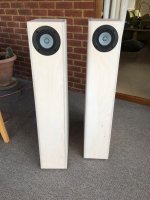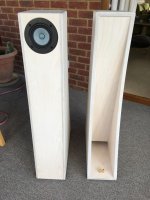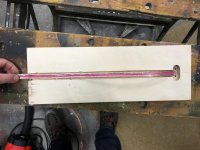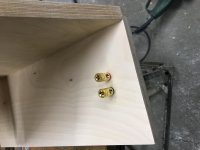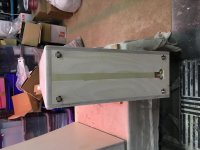Ah, yes. Didn't see that; 'twas exactly what I was looking for:He includes a multitone test, which no manufacturer dares to do. Also if you go here https://www.neurochrome.com/modulus-86-rev-2-1/ and scroll down you will see a graph of THD+N vs frequency.
What is missing that you need and what are you comparing to? I am not sure exactly sure.
40 watts into 8 Ω at <0.001% (-100 db), 20-20KHz
And the multi-tone test is impressive.
Quite a match for an LX Mini speaker system, methinks.
The LX Minis I listened to were pretty nice, well balanced and good sound for small group performances. A bit less liveliness compared to a live performance, some subtle note swaying and vocal skills presentation are missing. I think this is due to the highly damped material in the driver cones.
Sent from my iPhone using Tapatalk
Sent from my iPhone using Tapatalk
Have a look at Baxandall and Cordell publications regarding distortion measurements. There is nothing new, but...
Last edited:
Ah, yes. Didn't see that; 'twas exactly what I was looking for:
40 watts into 8 Ω at <0.001% (-100 db), 20-20KHz
Yep. Most of that is the +N of the measurement setup.
And the multi-tone test is impressive.
It's a neat test. According to Belcher (1978) it also correlates well with the perceived sound quality and it's a much more representative test of actual music signal than a pure tone test. I'd like to see it used more.
Quite a match for an LX Mini speaker system, methinks.
Indeed it is. That's in fact how I use mine. I like the minis. They're not LX521.4 level, but they're also a rather small fraction of the LK521.4 build budget. For residential settings, they're really quite nice and my Modulus-86/286 drives them well.
Have a look at Baxandall and Cordell publications regarding distortion measurements. There is nothing new, but...
Will do. You're right. Nothing new. I just need to push my test equipment to the max (and beyond).
Tom
push my test equipment to the max (and beyond).
"Work smarter, not harder"(c)
True. It'd have to be a rather steep filter to provide any meaningful attenuation at H2, though.
Steep doesn't mean a high order, can be a high-ish Q band pass or it can be something that looks like a Chebyshev type II low pass, but with nulls adjusted to harmonics etc.
Using internal AP sig gen can have some benefits. It may allow to do meaningful vector averaging (if necessary), synchronization FFT etc
Makes sense. It would be even nicer if the filter could auto-align to the carrier frequency. I like the idea of aligning the nulls in the Chebyshev-II to "swallow" the harmonics.
Tom
Tom
OK, so what's best to drive the LX Minis---four Modulus-86s or two Modulus-286s? For some reason, the 286 is MORE than 2x the cost of two 86s ($140 vs $130)I like the minis. They're not LX521.4 level, but they're also a rather small fraction of the LK521.4 build budget. For residential settings, they're really quite nice and my Modulus-86/286 drives them well.
Tom
And, why is your recommended supply at +/- 28 volts instead of the datasheet suggested +/- 35 volts? It seems that the higher voltage would provide more headroom, which you cannot have too much of--eh?
And, what about regulated supplies? Wouldn't they improve performance?
Last edited:
So I'm finally getting some listening in given that I have finished another project, a pair of Frugal Horn MK IIIs with MarkAudio Alpair 7P drivers.
What this has immediatley done is revealed the deficencies in the rest of the system. Namley my MP3 collection that was ripped for maxium device compatibility. So my first port of call is to re-rip the CDs to FLAC and find an improved media player over the current Squeezebox.
I'm also considering pre-amp options. Current thinking is something based around Tom's THAT driver so that I can use single ended sources.
What this has immediatley done is revealed the deficencies in the rest of the system. Namley my MP3 collection that was ripped for maxium device compatibility. So my first port of call is to re-rip the CDs to FLAC and find an improved media player over the current Squeezebox.
I'm also considering pre-amp options. Current thinking is something based around Tom's THAT driver so that I can use single ended sources.
Attachments
Last edited:
OK, so what's best to drive the LX Minis---four Modulus-86s or two Modulus-286s? For some reason, the 286 is MORE than 2x the cost of two 86s ($140 vs $130)
Since we're apparently speaking in all-caps now: It also provides BETTER PERFORMANCE (lower noise). It is also a FOUR LAYER BOARD (more expensive than two MOD86 boards). And it allows for PARALLEL OPERATION of the two channels (richer feature set).
And, why is your recommended supply at +/- 28 volts instead of the datasheet suggested +/- 35 volts?
That's one of the frequently asked questions on the LM3886. I've answered that enough times both in this thread and in others that I really should write a page on that and put it on my website. Here's the summary:
There are two things at play:
- Power dissipation in the LM3886 (thermal issue)
- Output current limit of LM3886 (output drive issue)
Secondly, the LM3886 is "only" guaranteed to be able to provide 7 A (peak) of output current. This means the highest supply voltage with a 4 Ω load should be ±7 * 4 = ±28 V.
It seems that the higher voltage would provide more headroom, which you cannot have too much of--eh?
Depends on how you define headroom. I can market the MOD86 as a 40 mW amp and get 60 dB of headroom or I can market it as a 40 W amp and have 0.2 dB of headroom. Headroom is mostly a marketing term. It basically means, "we designed a 100 W amplifier, sized the heat sink for 30 W and the power supply for 200 W. We then claim it's a 100 W amplifier (10 dB crest factor) with 3 dB of headroom (200 W supply)." In reality the amp will only deliver a 30 W sine wave continuously before overheating.
I don't operate that way. I prefer a honest approach. You can run my amps continuously at the specified output power under the conditions I give in the spec table and design documentation. To me that's the honest approach. Others will probably chastise me for crappy marketing, but honesty makes me sleep better at night.
And, what about regulated supplies? Wouldn't they improve performance?
With the regular LM3886 by itself, sure. You'll see an improvement from using regulated supplies. With the MOD86/286 due to their composite topology, you won't see a lick of difference below clipping.
Both the MOD86 and MOD286 are suitable for driving the LXmini. I use 4xMOD86 to drive my LXmini. If I was to build the amp today, I'd use 2xMOD286 for a lower build cost, slightly better performance, and easier assembly (I prefer SMD over leaded for assembly in many cases).
Your question about pricing does make me wonder if it's time to adjust the MOD86 pricing for inflation. It's been at $65 for coming up on three years now. 😉
Tom
Last edited:
As a contented user of an LMS-based server, very interested to see what you decide on this one. I see that IQAudio now do a version of their pi-DAC with balanced outputs. That was going to be my first port of call.find an improved media player over the current Squeezebox.
So I'm finally getting some listening in given that I have finished another project, a pair of Frugal Horn MK IIIs with MarkAudio Alpair 7P drivers.
Gary
How did you route the wires from the binding posts to the speaker?
Colin
As a contented user of an LMS-based server, very interested to see what you decide on this one. I see that IQAudio now do a version of their pi-DAC with balanced outputs. That was going to be my first port of call.
Colin,
Yes I have to say that over the years LMS & Squeezebox has got to be my most long lived and enjoyed bit of tech! I wake up every day to the Boom. I was wondering about modding it but given the tech has moved on so much I was thinking of a Pi and DAC combo. Volumio comes to mind with the Kali & Piano. I have also done a coulple of PiCore builds
How did you route the wires from the binding posts to the speaker?
I got my router out an created a slot on the underside and then filled it.
Attachments
Very neat job!
Nice to see a well-used B&D Workmate like mine too 🙂 They don't make them like that anymore.
Was the Frugel Horn a kit or did you do all the wood work from scratch?
Nice to see a well-used B&D Workmate like mine too 🙂 They don't make them like that anymore.
Was the Frugel Horn a kit or did you do all the wood work from scratch?
The workmate was a family hand em down and still going strong. Was even used in the build of the amp. The Frugel MkIII horn was a precut from CustomCans, good quality 18mm Birch ply.Very neat job!
Nice to see a well-used B&D Workmate like mine too 🙂 They don't make them like that anymore.
Was the Frugel Horn a kit or did you do all the wood work from scratch?
Hi Gary,
I used Frugalhorn with Alpair 7p drivers for quite some time on the end of my Modulus-86 amp too. Then I tried the XL's with 10p drivers, both were very good indeed so you must be having fun. Just recently sold both pairs as they weren't getting used much and the new owner is delighted.
Bill, glad you're making progress, it was you who set me on this neurochrome path so it's about time you got yours finished!
I used Frugalhorn with Alpair 7p drivers for quite some time on the end of my Modulus-86 amp too. Then I tried the XL's with 10p drivers, both were very good indeed so you must be having fun. Just recently sold both pairs as they weren't getting used much and the new owner is delighted.
Bill, glad you're making progress, it was you who set me on this neurochrome path so it's about time you got yours finished!
Yeah, all a bit slow, but will get there eventually 🙂 only 15 weeks left to complete or its another year hiatus.
Para 86 heatsink
The manual suggests using a heatsink with a coefficient of 0.7 K/W for one channel into a 4 ohm load. If I want to put both amp channels on a single heatsink is it as simple as using a heatsink with a coefficient of 0.35 or better?
The manual suggests using a heatsink with a coefficient of 0.7 K/W for one channel into a 4 ohm load. If I want to put both amp channels on a single heatsink is it as simple as using a heatsink with a coefficient of 0.35 or better?
- Home
- Amplifiers
- Chip Amps
- Modulus-86 build thread
